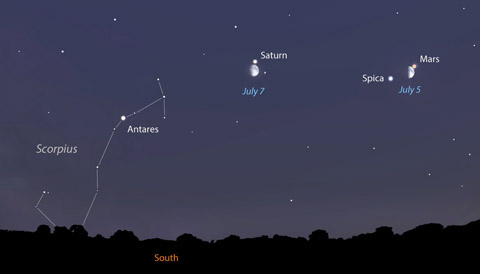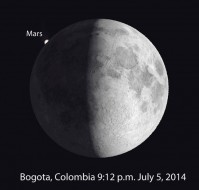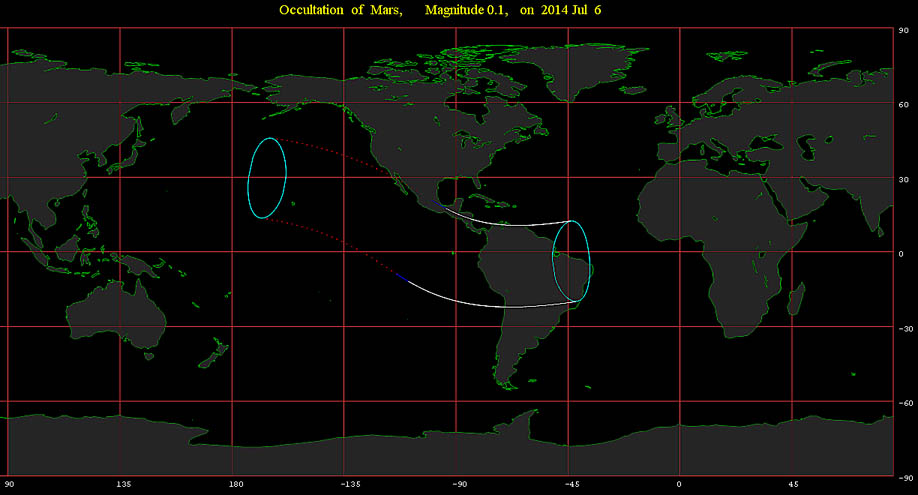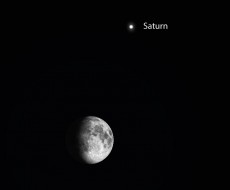On July 5th, the Moon has a remarkably close brush with Mars, followed two nights later by a similar rendezvous with Saturn.
July starts with a bang — and I'm not just talking about Independence Day fireworks!
Even if you're just a casual skywatcher, as darkness falls on July 5th you won't fail to note the Moon perched remarkably close to a ruddy "star" — actually the planet Mars — with the bright star Spica not far away. Then, two nights later, the Moon's eastward motion will park it close by the planet Saturn.

Source: Stellarium
Why are these close encounters occurring? The Moon's path through the sky closely follows the zodiac — the band of a dozen constellations home to the wanderings of the Sun and planets. As it cycles around the sky each month, the Moon glides by each of the eight planets for a brief nightly visit — called a conjunction.
The closer the conjunction and the brighter the planet the more striking the sight. I can't explain it, but few can resist the magnetic draw of two or more bright celestial objects side by side. We see beauty and meaning in these sometimes spectacular alignments.
July 5th: The Moon and Mars

Source: Stellarium
On July 5th, skywatchers across much of North America and Canada will see the first quarter Moon glide just 30 arcminutes (one full Moon diameter) south of fiery bright Mars in Virgo at nightfall. Their separation will vary depending on your location. Across the east-central U.S., they'll be about ½° apart — but the farther south you live, the choicer the view.
Intrepid observers up for a challenge can try spotting Mars shortly before sunset as it hovers just above the Moon's northern limb. (Hint: use binoculars.) Let me know, via a comment below, if you have success.

Source: Stellarium
From Miami, only 10 arcminutes separate two bodies, tight enough that both cratered lunar landscape and ruddy Martian deserts can be viewed in the same high-power telescopic field of view. By the time the sky's dark for observers on the West Coast, the Moon will have moved eastward in its orbit, putting some 1½° (three lunar diameters) between it and the Red Planet.
Jet down to Quito, Ecuador, and the Moon will completely block Mars from view during an occultation lasting up to an hour.
As the map below shows, the occultation zone extends from northern South America south of Caracas, Venezuela, across the Amazon Basin to northern Chile. For details on disappearance and reappearance times for cities across South America, check out the International Occultation Timing Association's Mars Occultation site<. Remember that the times shown there are Universal Time (UT); subtract 4 hours for EDT, 5 for CDT, 6 for MDT, and 7 for PDT.

Source: Occult 4
July 7th: The Moon and Saturn

Source: Stellarium
Two nights later, on July 7th, the now-gibbous Moon performs an encore, passing under Saturn during evening hours across North and South America. From mid-northern latitudes, about 1° will separate Moon and planet. Once again, viewers in South America will be graced with an occultation. Click here for a map and list of cities and times.
If you think that's all the celestial sphere has on its agenda this weekend, you'd be wrong. Saturday also marks the date the brightest asteroid Vesta makes a spectacular close approach to the largest asteroid, Ceres — taking place mere degrees from the Moon-Mars duo. Check out S&T.com's companion article for a map and more info on that conjunction. Such riches!
Get more great skywatching info — and the latest discoveries in astronomy — by downloading the July issue of Sky & Telescope.
 0
0









Comments
You must be logged in to post a comment.